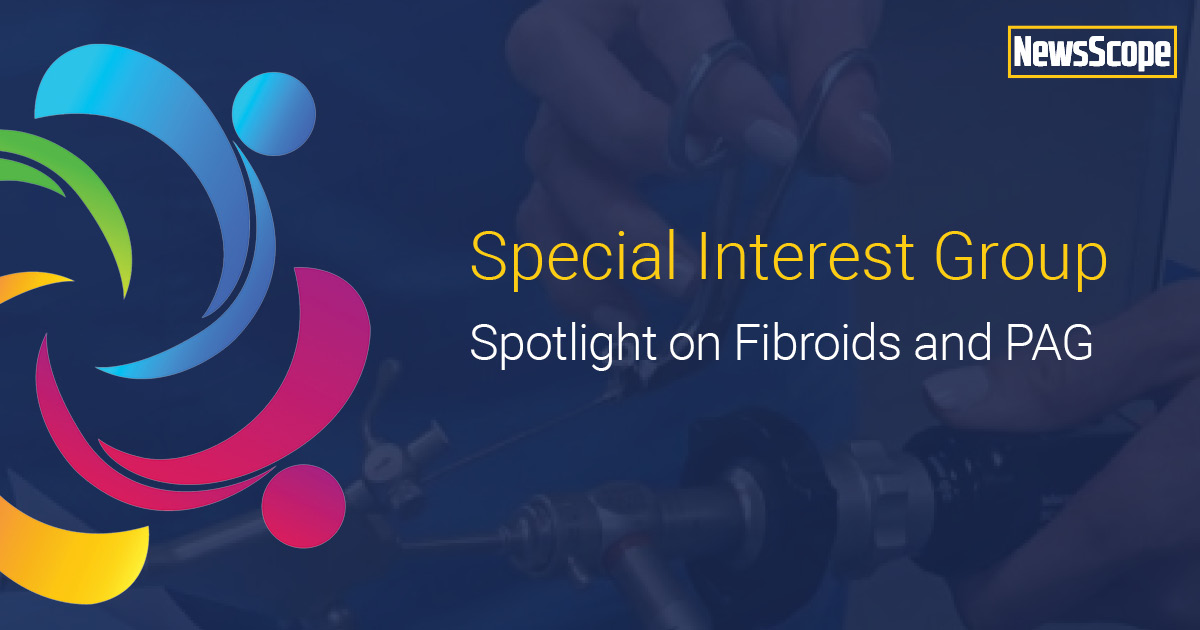Technology Feature Articles

Technology articles featured in this month’s issue were submitted from the Fibroids and Pediatric Adolescent Gynecology SIGS.
Thank you to all the AAGL SIG chairs, vice-chairs, and members – for these informative articles and submissions!
Fibroid SIG Technology Update: Radiofrequency Fibroid Ablation
Although the main focus of surgical techniques for fibroid treatment historically involved excisional procedures such as hysterectomy and myomectomy as the gold standard, radiofrequency fibroid ablation (RFA) has emerged as another non-invasive fibroid treatment option.
Targeted hyperthermic fibroid ablation, or myolysis, is a minimally invasive procedure that uses radiofrequency energy with low-voltage and alternating current to generate heat within the leiomyoma resulting in coagulative necrosis, leading to fibroid resorption and volume reduction. Ultrasound guidance allows placement of radiofrequency needles directly into the fibroid. The routes of RFA include laparoscopic, transvaginal, or transcervical. Currently in the United States, there are two devices FDA-approved for use: (1) Acessa (Hologic, 2012), laparoscopic RFA(L-RFA) and (2) Sonata (Gynesonics, 2018), transcervical RFA(TC-RFA). The L-RFA utilizes a 5mm laparoscopic port, 10mm laparoscopic ultrasound probe, and 2mm percutaneous electrosurgical probe. The TC-RFA is incisionless, as the handheld device contains both ultrasound and electrosurgical probe. RFA is indicated for intramural, and type 1-2 submucosal fibroids, and not for pedunculated or type 0 submucosal ones. Although there is no specific limit on the size and number of the fibroids being treated, it is inadvisable to treat a fibroid >10 cm with L-RFA. The TC-RFA creates ablations < 5cm, but multiple ablations can be used to treat larger fibroids.
RFA leads to decreased symptom severity, fibroid volume, menstrual bleeding and improved quality of life scores, with low complication rates and reintervention rates. The L-RFA pivotal trials reported a low reintervention rate of 4.8% and 11% after 2 and 3 years. Similarly, the pivotal trial for TC-RFA also reported a low reintervention rate of 5.5% and 8.2%-9.2%, after 2 and 3 years. Patient satisfaction was reported to be as high as 94-98%. A large systematic review that compared L-RFA, uterine artery embolization, focused ultrasound, and myomectomy reported no significant difference in reintervention rates and pregnancy rates.
Pregnancy outcome data is limited to case series and systematic reviews as the initial studies of RFA largely excluded women with future fertility desire. A case series of 30 pregnancies after L-RFA reported a miscarriage rate of 13.3%, similar to the general population, without having any cases of preterm delivery, abnormal placentation or uterine rupture. 86.7% resulted in a full term live birth with an equal distribution of vaginal and cesarean deliveries. A systematic review of 50 pregnancies after L- RFA and TC-RFA showed similar findings. There was no intrauterine adhesions or loss of uterine wall integrity after TC-RFA.
The current review of the literature suggests that RFA offers a safe and effective alternative treatment option for patients with symptomatic fibroids who seek uterine preservation. Although RFA is not yet approved by the FDA as a fertility-enabling treatment, subsequent successful pregnancy outcomes have been reported in the literature. More robust fertility data is required to confirm its safety for those who actively desire future pregnancy. RFA is another promising, conservative fibroid treatment and is looking to be an essential component of the minimally invasive gynecologist’s armamentarium.
Jin Hee (Jeannie) Kim, MD, FACOG
Associate Professor, Division of Gynecologic Specialty Surgery, Program Director, Fellowship in Minimally Invasive Gynecologic Surgery, Director, Center for Research and Advanced Fibroid Treatment (CRAFT), Department of Obstetrics and Gynecology, Columbia University Irving Medical Center/New York-Presbyterian Hospital

- Bradley LD, Pasic RP, Miller LE. Clinical performance of radiofrequency ablation for treatment of uterine fibroids: systematic review and meta-analysis of prospective studies. J Laparoendosc Adv Surg Tech A. 2019 Dec;29(1):1507-1517.
- Yu S, Bhagavath B, Shobeiri SA, Eisenstein D, Levy B. Clinical and patient reported outcomes pre- and post-surgical treatment of symptomatic uterine leiomyomas: A 12-month follow-up review of TRUST, a surgical randomized clinical trial comparing laparoscopic radiofrequency ablation (LAP-RFA) and myomectomy. J Minim Invasive Gynecol. 2022 Jan24;S1553-4650(22)00037-1.
- Berman JM, Shashoua A, Olson C, et al. Case series of reproductive outcomes after laparoscopic radiofrequency ablation of symptomatic myomas. J Minim Invasive Gynecol. 2020;27:639-645.
- Lin L, Ma H, Wang J et al. Quality of life, adverse events, and reintervention outcomes after laparoscopic radiofrequency ablation for symptomatic uterine fibroids: a meta-analysis. J Minim Invasive Gynecol. 2019 Mar-Apr;26(3):409-416.
- Kramer B, Hahn M, Taran FA, et al. Interim analysis of a randomized controlled trial comparing laparoscopic radiofrequency volumetric thermal ablation of uterine fibroids with laparoscopic myomectomy. Int J Gynaecol Obstet. 2016 May;133(2):206-11.
- Miller CE, Osman KM. Transcervical radiofrequency ablation of symptomatic uterine fibroids: 2-year results of the Sonata pivotal trial. J Gynecol Surg. 2019 Dec 1;35(6):345-349.
- Lukes A, Green MA. Three-year results of the Sonata pivotal trial of transcervical fibroid ablation for symptomatic uterine myomata. J Gynecol Surg. 2020 Oct 1;36(5)228-233.
- Garza-Leal JG. Long-term clinical outcomes of transcervical radiofrequency ablation of uterine fibroids: The VITALITY study. J Gynecol Surg. 2019 Feb 1;35(1):19-23.
- Ito T, Mattingly P, Jan AG, Biscette SM, Kim JH. Alternatives to excisional therapy: a clinical review of our current options to conservatively manage symptomatic leiomyomas. Curr Opin Obstet Gynecol. 2018 Aug;30(4):279-286.
- Guido RS, Macer JA, Abbott K, et al. Radiofrequency volumetric thermal ablation of fibroids: a prospective, clinical analysis of two years’ outcome from the Halt trial. Health Qual Life Outcomes. 2013;11:139.
- Berman JM, Guido RS, Garza Leal JG, et al; Halt Study Group. Three-year outcome of the Halt trial: a prospective analysis of radiofrequency volumetric thermal ablation of myomas. J Minim Invasive Gynecol. 2014 Sep-Oct;21(5):767-74.
- Polin M, Hur HC. Radiofrequency ablation of uterine fibroids and pregnancy outcomes: an updated review of the literature. J Minim Invasive Gynecol. 2022 Feb 2:S1553-4650(22)00045-0.
PAG SIG Technology Update
Smaller genital structures and thin mucosa in prepubertal patients are subject to increased risk of iatrogenic trauma. (1) Considerations for operative hysteroscopy, including choice of instrument, cervical dilation/preparation and pressure and fluid management cannot simply be extrapolated from adult populations owning to anatomical and physiological differences as well as emotional maturity.
Advancements in the production of smaller diameter fiber optic endoscopes (1.2 to 5 mm) has allowed for an integrated system for magnification and are now routinely used for evaluation of the cervix and vagina via vaginoscopy. (2) Less is known about the use of these systems for hysteroscopic evaluation in the prepubertal patient.
The smaller outer diameter and shorter working lengths make operative pediatric cysto-urethroscopes particularly useful. The KARL STORZ system offers a 9.5 Fr 130 mm length endoscope which includes a 6 Fr working channel for limited instrumentation. The 9 Fr 120 mm pediatric resectoscope offers the ability to resect and apply electrocautery, however is limited due to smaller visual field it provides. (3)
Hysteroscopes may be used for access and a variety of flexible or rigid endoscopes are available for clinical use. However, many remain limited by relatively larger diameter requiring increased mechanical dilation and longer working lengths of 205 to 300 mm.
Flexible scopes such as the OLYMPUS 3.1mm HFY-XP and KARL STORZ 3.5 mm, are commonly in use. Disposable handheld devices Endosee ® Advance and LiNA OperaScope ™ may offer added convenient alternatives to the traditional hysteroscopic systems. These devices may be particularly valuable in the Pediatric and Adolescent Gynecology practice as a practical tool for examination of the vagina as tolerated in the outpatient setting. However, as access to the endometrium will require anesthesia these devices are less valuable in the pediatric patient owning to the poorer optical viewing compared to rigid scopes.
Smaller rigid hysteroscopes with an outer diameter of 4-5 mm with a 5 Fr working channel for semi rigid instruments such as offered by KARL STORZ offer improved optical viewing (6). It is limited by the requirement for 15 Fr resectoscope. (4) The Truclear ™ and Myosure® systems offer a convenient see and treat approach with mechanical energy which may be preferable in the smaller endometrial cavity. The Truclear ™ system currently offers a 5mm.
Careful consideration for the adaptation of endoscopes for operative hysteroscopy in the pre-pubertal patient is paramount. Currently available hysteroscopes and pediatric cystoscopes are of value in this setting, however both have their own limitations.
- Noam Smorgick et.al. Diagnosis and treatment of pediatric vaginal and genital tract abnormalities by small diameter hysteroscope. J Pediatr Surg. 2009 Aug;44(8):1506-8
- Jolinda Johary et.al. Use of hysteroscope for vaginoscopy or hysteroscopy in adolescents for the diagnosis and therapeutic management of gynecologic disorders: a systematic review. J Pediatr Adolesc Gynecol. 2015 Feb;28(1):29-37
- Gobbi et.al. Instrumentation for minimally invasive surgery in pediatric urology. Transl Pediatr 2016 Oct;5(4):186-204
- Bettocchi, Stefano & Di Spiezio Sardo, Attilio & Ceci, Oronzo. (2009). Instrumentation in Office Hysteroscopy: Rigid Hysteroscopy. p 1-6
Smaller genital structures and thin mucosa in prepubertal patients are subject to increased risk of iatrogenic trauma. (1) Considerations for operative hysteroscopy, including choice of instrument, cervical dilation/preparation and pressure and fluid management cannot simply be extrapolated from adult populations owning to anatomical and physiological differences as well as emotional maturity.
Advancements in the production of smaller diameter fiber optic endoscopes (1.2 to 5 mm) has allowed for an integrated system for magnification and are now routinely used for evaluation of the cervix and vagina via vaginoscopy. (2) Less is known about the use of these systems for hysteroscopic evaluation in the prepubertal patient.
The smaller outer diameter and shorter working lengths make operative pediatric cysto-urethroscopes particularly useful. The KARL STORZ system offers a 9.5 Fr 130 mm length endoscope which includes a 6 Fr working channel for limited instrumentation. The 9 Fr 120 mm pediatric resectoscope offers the ability to resect and apply electrocautery, however is limited due to smaller visual field it provides. (3)
Hysteroscopes may be used for access and a variety of flexible or rigid endoscopes are available for clinical use. However, many remain limited by relatively larger diameter requiring increased mechanical dilation and longer working lengths of 205 to 300 mm.
Flexible scopes such as the OLYMPUS 3.1mm HFY-XP and KARL STORZ 3.5 mm, are commonly in use. Disposable handheld devices Endosee ® Advance and LiNA OperaScope ™ may offer added convenient alternatives to the traditional hysteroscopic systems. These devices may be particularly valuable in the Pediatric and Adolescent Gynecology practice as a practical tool for examination of the vagina as tolerated in the outpatient setting. However, as access to the endometrium will require anesthesia these devices are less valuable in the pediatric patient owning to the poorer optical viewing compared to rigid scopes.
Smaller rigid hysteroscopes with an outer diameter of 4-5 mm with a 5 Fr working channel for semi rigid instruments such as offered by KARL STORZ offer improved optical viewing (6). It is limited by the requirement for 15 Fr resectoscope. (4) The Truclear ™ and Myosure® systems offer a convenient see and treat approach with mechanical energy which may be preferable in the smaller endometrial cavity. The Truclear ™ system currently offers a 5mm.
Careful consideration for the adaptation of endoscopes for operative hysteroscopy in the pre-pubertal patient is paramount. Currently available hysteroscopes and pediatric cystoscopes are of value in this setting, however both have their own limitations.
Gylynthia E. Trotman, MD, MPH, FACOG
Chief of Pediatric and Adolescent Gynecology, Assistant Professor of Obstetrics and Gynecology and Assistant Professor of Pediatrics at Icahn School of Medicine at Mount Sinai Health System/Kravis Children’s Hospital.

- Noam Smorgick et.al. Diagnosis and treatment of pediatric vaginal and genital tract abnormalities by small diameter hysteroscope. J Pediatr Surg. 2009 Aug;44(8):1506-8
- Jolinda Johary et.al. Use of hysteroscope for vaginoscopy or hysteroscopy in adolescents for the diagnosis and therapeutic management of gynecologic disorders: a systematic review. J Pediatr Adolesc Gynecol. 2015 Feb;28(1):29-37
- Gobbi et.al. Instrumentation for minimally invasive surgery in pediatric urology. Transl Pediatr 2016 Oct;5(4):186-204
- Bettocchi, Stefano & Di Spiezio Sardo, Attilio & Ceci, Oronzo. (2009). Instrumentation in Office Hysteroscopy: Rigid Hysteroscopy. p 1-6



